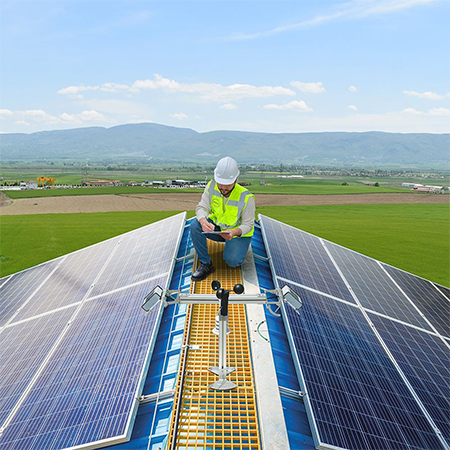Modern solar power systems, especially rooftop projects, are adopting 2-orientations mounting layouts. To capture a true picture of system performance, it is essential to measure solar irradiance from both orientations. The SEVEN Dual Orientation Irradiance Sensor provides just that: simultaneous monitoring of irradiance on two planes, helping operators fine-tune performance and maximize energy yield.
What Is a Dual Orientation Irradiance Sensor?
A Dual Orientation Irradiance Sensor is designed to measure solar irradiance on two distinct surfaces, typically two different tilt or azimuth angles.

By tracking irradiance from two planes, this sensor provides the total effective irradiance value by considering the number of PV modules in each orientation. The total effective irradiance sensor is used to calculate the performance of the PV Plant.

Where:
- Actual Energy Output = Actual reading of the plant
- Expected Energy Output = Theoretical, calculated nominal energy output based on the total effective irradiance, defined as:

- IS1: Irradiance from Orientation 1
- IS2: Irradiance from Orientation 2
Key Features of Dual Orientation Irradiance Sensor
- Two Independent Silicon Sensors: Mounted at the same angles as PV Modules to track solar radiation from both orientations.
- High Accuracy: Each sensor is factory calibrated and optimized for directional response.
- Compact, Durable Design: Weatherproof housing (IP54), designed for long-term rooftop or ground-mount use.
- Ready-to-Install Bracket: Pre-angled mounts for easy installation at desired tilt angles.
How Does the Dual Orientation Irradiance Sensor Work?
The sensor includes two matched irradiance sensors, mounted to represent the two orientations you wish to monitor (e.g., east-facing and west-facing, or different tilt angles). The sensor delivers both irradiance values, as well as the total effective irradiance calculated based on the number of panels in each orientation, which is pre-defined through the Configuration tool of SEVEN.
Why Use a Dual Orientation Sensor?
Instead of dividing the sites with different orientations as separate sites, which means separate inverters and separate dataloggers, the Dual Orientation Irradiance Sensor is cost effective and allows the user to calculate the accurate performance ratio.
Integration and Compatibility
This sensor is ready to integrate with:
- SCADA Systems
- Inverter monitoring systems
- Custom data loggers
With its Modbus output feature, it ensures compatibility with all common industrial monitoring interfaces.
Best Practices for Optimal Accuracy
To ensure reliable and consistent data:
- Mount sensors at the correct tilt and azimuth to match your actual array orientation.
- Keep sensor surfaces clean and regularly inspect for soiling.
- Avoid partial shading from module frames, cables, or structural components.
SEVEN Dual Orientation Irradiance Sensor: Capture the Complete Picture
Solar energy systems are becoming more dynamic, and so should your monitoring tools. With dual-plane measurement, the SEVEN Dual Orientation Irradiance Sensor helps you monitor performance more completely, optimize energy yield, and detect hidden issues early.
Need help selecting the right orientation or integration method?
Contact SEVEN for expert configuration support, custom mounting solutions, and data interface guidance.
